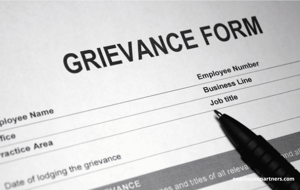Grievance Policy and Procedure: A Comprehensive Guide for Employers
Access a comprehensive grievance policy template designed for UK employers to support fair, transparent, and compliant grievance handling in the workplace.
James Rowland
Commercial Director James leads Account Management, Sales and Marketing at Neathouse Partners.Date
05 November 2024Updated
12 November 2024
Table of contents
Related articles
Tags
A robust grievance policy is essential to creating a fair and respectful workplace.
It provides employees with a structured process to raise concerns about issues that impact their work environment.
For employers, a grievance policy reduces the risk of workplace disputes escalating into more serious issues.
This guide will cover the essentials of a grievance policy, from its purpose to the specifics of UK legislation and case law, and even offer a downloadable template.
By understanding the importance and structure of a grievance policy, employers can better protect their business and support their employees.
Downloadable Grievance Policy Template (UK)
Download our grievance policy template to streamline the process. This template provides a structured, legally compliant framework tailored to UK best practices.
What is a Grievance Policy?
A grievance policy is a formal document outlining how employees can raise complaints or concerns.
These grievances typically relate to workplace issues, such as discrimination, harassment, bullying, or unfair treatment.
A well-crafted grievance policy also promotes a positive culture by ensuring grievances are handled constructively and transparently.
In the absence of a grievance policy, employees may feel unsupported, which can lead to disengagement or even tribunal claims.
Why is a Grievance Policy Essential?
The presence of a grievance policy demonstrates an employer’s commitment to fairness and transparency.
It reassures employees that their concerns will be taken seriously and handled impartially.
From a business perspective, grievance policies help maintain workplace morale by resolving issues before they escalate.
A clear policy can also protect against costly employment tribunal claims, as it provides a structured approach for dispute resolution.
Additionally, it helps managers handle complaints consistently and within legal guidelines.
In the UK, employers are legally obligated to provide a formal grievance procedure, as required by ACAS guidance and certain employment laws.
UK Legal Requirements and Guidelines
In the UK, adherence to the Employment Rights Act 1996 and ACAS Code of Practice on Disciplinary and Grievance Procedures is essential.
The Employment Rights Act sets out that employees must be treated fairly in the workplace.
The ACAS Code, while not legally binding, establishes best practices for handling grievances.
Failure to follow the Code may result in increased tribunal awards of up to 25%, which can have serious financial implications for employers.
Following these guidelines demonstrates compliance with UK best practices and reduces the likelihood of legal challenges.
Key Components of a Comprehensive Grievance Policy
A comprehensive grievance policy should be clear, accessible, and contain the following elements:
-
Policy Scope: Define the types of complaints covered, including bullying, harassment, discrimination, health and safety concerns, and unfair treatment.
-
Informal Resolution: Include a stage encouraging informal discussions between employees and managers as a first step.
-
Formal Grievance Procedure: Detail the steps for formally raising a grievance, including timelines and methods for submitting complaints.
-
Roles and Responsibilities: Clarify the roles of employees, managers, HR, and any external investigators.
-
Investigation Process: Outline how grievances will be investigated to ensure thorough and impartial handling.
-
Right to Representation: Allow employees to be accompanied by a colleague or union representative during formal grievance hearings.
-
Grievance Hearing: Specify the procedure for a formal hearing, where both parties can present evidence and call witnesses if necessary.
-
Outcome and Communication: Detail how decisions will be communicated to the complainant, including any follow-up actions.
-
Appeal Procedure: Provide employees with the option to appeal if they feel the grievance was not handled appropriately.
-
Confidentiality Clause: Stress the importance of confidentiality throughout the process to protect the privacy of all parties.
Step-by-Step Guide to the Grievance Procedure
A robust grievance procedure will typically involve the following steps:
1. Encouraging Informal Resolution
Employees are first encouraged to discuss their issues informally with their manager or HR.
Many grievances can be resolved through simple conversation, which saves time and maintains goodwill.
Encouraging informal resolution also demonstrates openness and a commitment to quickly addressing concerns.
2. Submitting a Formal Complaint
If informal discussion does not resolve the issue, the employee may submit a formal grievance in writing.
The complaint should include details of the issue, individuals involved, and any desired outcomes.
This step initiates the formal grievance process and must be acknowledged promptly by the employer.
3. Investigation Process
An impartial investigator, usually a member of HR or an external consultant, conducts a thorough investigation.
This involves interviewing relevant parties, reviewing evidence, and gathering any necessary documentation.
Investigations should be completed within a reasonable timeframe, with regular updates provided to the complainant.
4. Grievance Hearing
Once the investigation concludes, a grievance hearing is held, where the complainant and any witnesses can present their evidence.
The hearing provides an opportunity for the employee to discuss their concerns in depth.
The employer should also present any findings from the investigation.
5. Communication of Outcome
Following the hearing, a written outcome should be provided to the employee.
The outcome letter should include the decision, reasoning, and any actions to be taken.
This ensures transparency and maintains a record of the grievance process.
6. Right to Appeal
If the employee is dissatisfied with the outcome, they have the right to appeal.
The appeal process must be conducted by a different manager or impartial representative to ensure fairness.
The appeal provides a final opportunity to resolve the issue within the company before further action is pursued.
Examples of Grievance Scenarios
Grievance policies apply to various workplace situations, such as:
-
Harassment Claims: If an employee experiences harassment, they may use the grievance process to formally address the issue.
-
Discrimination Complaints: Employees who believe they are being discriminated against can file a grievance to have the matter investigated.
-
Health and Safety Concerns: Employees can raise health and safety issues, which may lead to adjustments in the workplace.
For example, in Malik v Bank of Credit and Commerce International SA (BCCI) [1997], the employee alleged that the employer's failure to maintain a fair and respectful work environment amounted to a breach of the implied term of mutual trust and confidence.
This case highlighted the importance of employers maintaining an environment where grievances can be freely raised and investigated without fear of retaliation.
Relevant Case Law and Examples
The importance of a fair grievance process is reinforced in cases like Shamoon v Chief Constable of the Royal Ulster Constabulary [2003].
Here, the court highlighted the need for employers to take grievances seriously and follow a formal process.
Another case, Kaur v Leeds Teaching Hospitals NHS Trust [2018], emphasised the employee’s right to appeal and the need for a thorough investigation.
These cases illustrate how a well-documented grievance policy can support both employees and employers in the event of disputes.
The Role of Managers in Grievance Handling
Managers play a key role in the grievance process, as they are often the first point of contact.
Training managers on grievance handling helps ensure a consistent, fair approach across the organisation.
Managers should be familiar with the informal and formal stages of the grievance policy.
They should also understand the importance of impartiality and confidentiality.
Clear communication from managers is essential, as it builds trust and reassures employees that their concerns are taken seriously.
Common Pitfalls in Grievance Handling and How to Avoid Them
Many employers make mistakes when handling grievances, such as:
-
Failure to Document: Not recording each step can create issues if a grievance escalates.
-
Delaying the Process: Failing to address complaints promptly damages employee trust.
-
Inconsistent Application: All complaints should be treated with equal seriousness and handled consistently.
Avoiding these pitfalls builds a strong, credible grievance process that benefits everyone involved.
Preventive Measures for a Positive Workplace Culture
Prevention is often the best approach to grievance management.
Encouraging open communication, providing regular feedback, and addressing issues informally can reduce formal grievances.
By promoting a respectful and inclusive workplace, employers can minimise the risk of grievances arising.
Regular training on workplace behaviours and company policies can further reinforce positive culture.
Ongoing Review and Improvement of the Grievance Policy
A grievance policy should not remain static but evolve with the workplace.
Regularly reviewing the policy ensures it remains effective and up-to-date with current legislation.
Employee feedback can also help identify areas for improvement in the grievance process.
Continuous improvement helps maintain the policy’s relevance and strengthens the workplace’s trust in the grievance system.
Conclusion
A well-structured grievance policy is crucial for every employer.
It fosters a fair, transparent, and respectful workplace culture.
By following a structured procedure, employers can minimise risks and demonstrate commitment to fair treatment.
For any business, a grievance policy is not only best practice but also an essential tool in maintaining employee trust.
Related blog posts

Right To Be Accompanied During a Grievance or Disciplinary Meeting

When the Grievance Becomes the Problem - Serial Grievance Raisers

Grievance Procedure Time Limits - What You Need To Know

When Can You Refuse A Flexible Working Request?
Have questions?
Get in touch today
Contact us, and our team will get back to you within 24 hours. We value your questions and are committed to getting them answered quickly.


Hello! I am Nicky
Just fill in the form below with your details, and I will arrange for a member of our team to give you a call.
By clicking, you agree to our Privacy Policy




